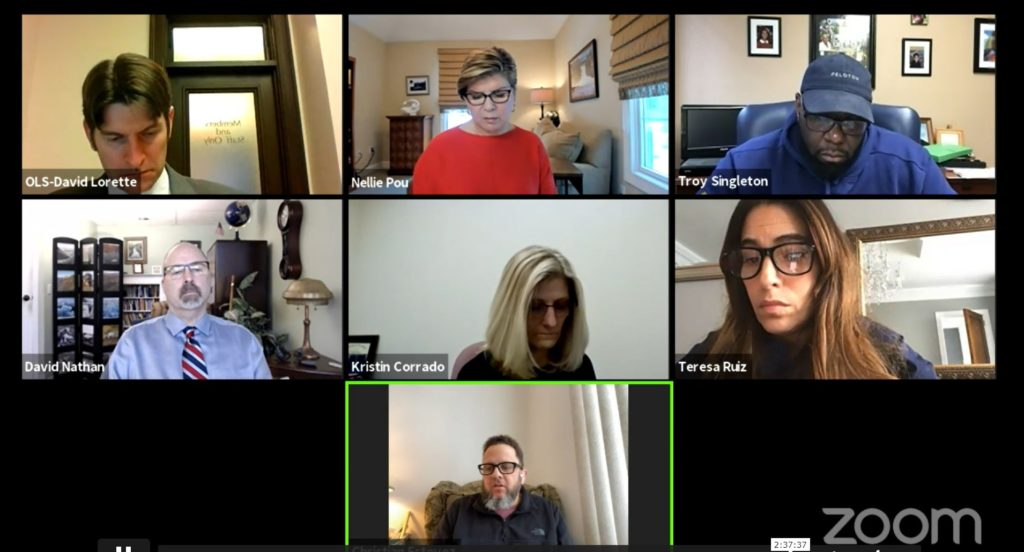This morning JerseyCAN released the first statewide report that quantifies learning loss for New Jersey students during the COVID-19 school closures and reliance on remote instruction. Results, as described in “A Time to Act: COVID-19 Academic Slide in New Jersey,” will come as no surprise for those following parent/teacher/district concerns about student achievement: Compared to 2019 statewide proficiency numbers for students in grades 3-8, the report projects a 30 percentile point drop in English Language Arts (ELA) proficiency and a 36 percentile point drop in math proficiency. Also, student learning loss is disproportionately borne by low-income, Black, and Latino families: more than 300,000 students in large urban districts such as Newark, Paterson, and Jersey City have gone more than a year without in-school instruction.
The report was funded by the New Jersey Children’s Foundation,* a nonprofit that promotes a fact-based discussion about public education in New Jersey.
At a (virtual) press conference yesterday afternoon, Senator Teresa Ruiz, JerseyCAN’s Executive Director Patricia Morgan, and Urban League of Essex County President Vivian Cox-Fraser gave an overview of the results and described the significance of the findings, which should guide what New Jersey does next to help students recover from a loss that could permanently forestall academic success. “This report,” said Morgan, “needs to be a launching pad for a very robust statewide conversation about our students’ education recovery.”
A little background: In order to quantify learning loss, JerseyCAN contracted with EmpowerK12, a non-profit specializing in education data systems and strategic analysis. Eighteen thousand students in 15 districts and charter schools took one of two adaptive assessments: either NWEA’s Measures of Academic Progress (MAP) or the i-Ready Diagnostic. These tests are aligned with New Jersey’s own standardized tests, our NJ Student Learning Assessments (NJSLA) and, thus, are predictive of what will happen a year from now without a strategic plan to get kids back on track.
Here are EmpowerK-12’s findings:
- On average, New Jersey students lost 30% of expected learning in ELA and 36% of expected learning in Math, but the loss was greater for Black students, who lost on average 43% in ELA and 50% in Math.
- Latino students lost 37% of expected learning in ELA and 40% in Math.
- Economically disadvantaged students experienced a learning loss of approximately 40% in ELA and learning loss in Math of 43%, significantly higher than wealthier students.
Extrapolating from these results, approximately 393,000 students in ELA and 430,000 students in math will not be on grade level by the end of this school year.
Morgan described this level of learning loss as “precipitous,” especially for low-income students already left behind. Another way of thinking about the results is that nearly 2 out of every 5 students who were previously proficient in ELA on the NJSLA. are no longer on-track, and about 1 out of every 2 who were proficient in Math in Spring 2019 are not meeting or exceeding expectations anymore. “It is critically important,” she said, for “our state leaders and parents to have a sense of how students are faring. Without that, we won’t be able to have a meaningful discussion.”
“Without knowing the problem you’re solving for,” said Morgan, “ you can’t solve it.”
Worth noting here is the solutions will be well-funded by the enormous amount of money NJ will receive from the federal government through the Biden Administration’s American Rescue Plan Act of 2021 (ARPA). This bill includes $123 billion for K-12 schools — more money than the feds have ever directed towards state school systems. According to U.S. Senator Cory Booker’s office
, New Jersey’s share for K-12 is close to $2.8 billion, with $138.2 million reserved to address learning loss, $27.6 million reserved for summer enrichment, and $27.6 million reserved for afterschool programs.
But it’s only monopoly money unless we use it strategically.
What does that look like?
For Senator Ruiz (who broke down in tears several times while describing the “heart-breaking” toll of COVID-19 learning loss on families who “don’t have a mother who went to college, reliable broadband internet, and more than one tablet”), this means districts must start now to create “valuable programs for individualized learning plans” and “intense tutoring plans” that students must be able to access starting this summer and throughout the 2021-2022 school year.
“Everyone knows I’m always talking about equity,” she said. “We are now creating these structures. Some kids haven’t missed a beat because their parents have resources. Our private and Catholic school rosters are more robust than they’ve ever been. This is an opportunity for NJ to think out of the box. I’m looking forward to districts creating these systems.” (To that end, Ruiz just dropped a bill that would require the state Department of Education to launch “a full effort to gather data.”)
“We should all feel heartbroken without a doubt,” said Ruiz, “but we should be encouraged about what the truth in this report can lend itself to.”
In order to look honestly at student learning, Morgan, Ruiz, and Cox-Frazer agreed, it is imperative that the state Department of Education administer the usual state standardized tests in spring 2022 so that we can compare results to spring 2019. If the state changes the test (as it has threatened to do), we’ll lose the ability to accurately gauge student learning. Without that ability, students won’t get what they need.
“New Jersey schools are #1 in spending,” said Morgan, “and now we can really earn our title by honing in on equity gaps to truly be able to call ourselves the #1 state school system in the country.” Ruiz concurred: “Let’s be “#1 in closing the achievement gap.”
*New Jersey Children’s Foundation is a grantor to brightbeam, which supports this platform.



